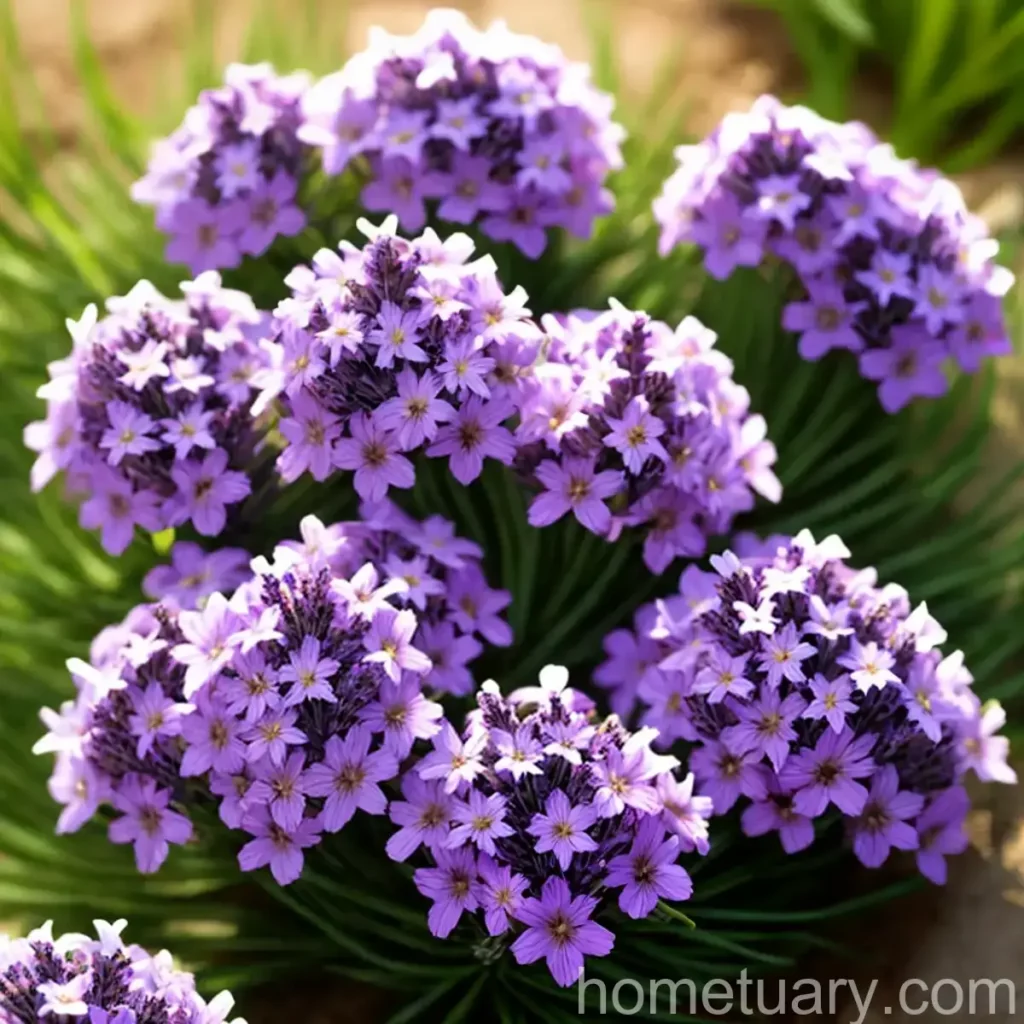Moss Phlox (Phlox subulata ‘Bedazzled Lavender’): A Complete Guide to Care, Growth, and Maintenance
Plants are an essential part of our environment, bringing beauty, life, and functionality to our surroundings. Moss phlox, scientifically known as Phlox subulata ‘Bedazzled Lavender,’ is a versatile, low-growing perennial that offers a stunning display of colorful flowers and serves various purposes in landscaping and gardening. In this comprehensive guide, we will explore the key aspects of moss phlox care, including its cultivation, uses, maintenance, and common diseases and pests. Whether you are a seasoned gardener or a beginner looking to enhance your green space, this article will equip you with the knowledge and insights to successfully grow and maintain moss phlox.
What is Moss Phlox (Phlox subulata ‘Bedazzled Lavender’)?
Moss phlox, or Phlox subulata ‘Bedazzled Lavender,’ belongs to the Polemoniaceae family and is native to parts of North America. It is a mat-forming perennial that features small, needle-like evergreen leaves and an abundance of delicate, star-shaped flowers. The ‘Bedazzled Lavender’ variety is particularly prized for its distinctive lavender-colored blooms, adding a pop of color to gardens, borders, and rockeries.
Key Takeaways – Moss Phlox (Phlox subulata ‘Bedazzled Lavender’)
Before delving into the specifics of moss phlox care, let’s highlight the key takeaways that will be addressed in this comprehensive guide:
- Moss Phlox Culture
- Uses of Moss Phlox
- Water Requirements
- Sunlight Preferences
- Fertilization Needs
- Ideal Soil Conditions
- Pruning Techniques
- Propagation Methods
- Growing Moss Phlox in Containers
- Popularity and Common Varieties
- Common Diseases and Diagnosis
- Identification and Management of Common Pests
- Botanist’s Tips for Successful Cultivation
- Fun Facts about Moss Phlox
Now, let’s explore each of these aspects in detail to gain a comprehensive understanding of moss phlox care and cultivation.
Moss Phlox Culture
Cultivating moss phlox involves understanding its fundamental requirements and preferences, including soil, water, and sunlight conditions. By providing the appropriate cultural care, you can ensure the optimal growth and development of these stunning perennials.
Uses
Moss phlox, with its low-growing and spreading nature, serves several practical and aesthetic purposes in landscaping and gardening:
- Ground Cover: Its dense, mat-forming growth habit makes it an excellent choice for ground cover, helping to control erosion and suppress weed growth.
- Rock Gardens: Moss phlox thrives in rocky, well-draining environments, making it an ideal addition to rock gardens and alpine landscapes.
- Borders and Edging: The low, spreading nature of moss phlox lends itself well to creating defined borders and edging around flower beds and walkways.
- Slopes and Embankments: Its ability to spread and fill in spaces makes it a valuable plant for stabilizing slopes and embankments, preventing soil erosion.
- Container Gardening: Moss phlox can be grown in containers and hanging baskets, adding vibrant color and texture to patios, balconies, and other outdoor spaces.
Understanding the diverse uses of moss phlox can guide you in selecting the most suitable location and application for this versatile plant within your garden or landscape.
Water
Proper watering is crucial for the health and vigor of moss phlox. While it is relatively drought-tolerant once established, consistent moisture is important, especially during the establishment phase and in periods of prolonged dryness. Here are some essential considerations for watering moss phlox:
- Establishment: Newly planted moss phlox should be watered regularly to encourage root establishment and growth. Provide sufficient moisture without waterlogging the soil.
- Mature Plants: Once established, moss phlox generally requires minimal watering, except during extended dry spells. Water deeply but infrequently to promote deep root development and resilience to drought conditions.
- Signs of Water Stress: Keep an eye out for signs of water stress, such as wilting or browning of foliage, which may indicate the need for supplemental watering.
Understanding the specific water requirements of moss phlox will enable you to provide the appropriate moisture levels, promoting healthy growth and vibrant blooms.
Sunlight
Moss phlox thrives in sunny locations with ample direct sunlight, making it well-suited for gardens and landscapes with full sun exposure. When considering sunlight preferences for moss phlox, keep the following tips in mind:
- Full Sun: To ensure robust growth and prolific flowering, plant moss phlox in areas that receive at least 6-8 hours of direct sunlight per day. Insufficient sunlight may result in leggy growth and diminished flowering.
- Shade Avoidance: Moss phlox prefers to avoid shaded or partially shaded areas, as reduced sunlight can compromise its overall health and flowering performance.
- Heat Tolerance: While moss phlox enjoys full sun, it also exhibits good heat tolerance, making it suitable for regions with warmer climates.
By selecting suitable sunny locations for moss phlox, you can create an optimal environment for its growth and floral display.
Fertilizer
Appropriate fertilization plays a vital role in enhancing the growth and blooming potential of moss phlox. When providing fertilization for this perennial, consider the following guidelines:
- Minimal Fertilization: Moss phlox typically thrives in nutrient-poor soil and requires minimal fertilization once established. Excessive fertilization can lead to lush foliage at the expense of abundant flowering.
- Spring Application: If necessary, apply a balanced, slow-release fertilizer in early spring to support the initial growth and development of moss phlox.
- Avoid High Nitrogen: Refrain from using high-nitrogen fertilizers, as they can promote excessive vegetative growth at the expense of flower production.
By adopting a conservative and strategic approach to fertilization, you can encourage healthy growth and profuse flowering in Moss phlox.
Soil
Moss phlox exhibits a preference for well-draining, lean soils, making it well-suited for various soil types and growing conditions. Consider the following soil-related factors for optimal cultivation of moss phlox:
- Drainage: Well-draining soil is essential for moss phlox, as it helps prevent waterlogging and root rot. Ensure that the planting site or container has good drainage to support healthy growth.
- Soil pH: Moss phlox thrives in slightly acidic to neutral soil with a pH range of 5.5 to 7.0. Conduct a soil pH test and amend the soil as needed to maintain the appropriate pH levels.
- Soil Types: Moss phlox adapts well to various soil types, including sandy, loamy, and rocky soils. Its versatility makes it suitable for a wide range of growing conditions.
Understanding and providing the ideal soil conditions for moss phlox will contribute to its overall health, vigor, and resilience.
Pruning
Pruning is an important aspect of moss phlox maintenance, helping to enhance its appearance, control its growth, and promote prolific blooming. Consider the following pruning techniques and recommendations for moss phlox:
- Deadheading: After the initial bloom period, promptly remove spent flowers by deadheading to encourage additional blooming and maintain a neat, tidy appearance.
- Shearing: Light shearing or trimming of the foliage after flowering can help rejuvenate the plant and promote denser growth.
- Thinning: Periodically thin out dense patches of moss phlox to improve air circulation and minimize the risk of disease and pest issues.
By incorporating regular pruning into your moss phlox care routine, you can maximize its visual appeal and longevity in the garden.
Propagation
Moss phlox can be propagated through various methods to expand your plantings and share its beauty with others. Consider the following propagation techniques for moss phlox:
- Division: Divide mature clumps of moss phlox every 3-4 years in early spring or early fall to create new plants. Separate the rooted sections and transplant them into prepared soil.
- Stem Cuttings: Take stem cuttings from healthy, non-flowering shoots in late spring or early summer. Root the cuttings in a moist, well-draining medium to establish new plants.
- Seed Sowing: While less commonly practiced, moss phlox can be grown from seeds. Sow seeds indoors in early spring and transplant seedlings into the garden after the last frost.
By employing these propagation methods, you can propagate moss phlox effectively and sustainably, ensuring a continuous supply of these beautiful perennials.
Growing Moss Phlox in Containers
Moss phlox is also well-suited for container gardening, allowing you to enjoy its vibrant blooms and spreading growth habit in confined spaces, such as patios, balconies, and decks. Here are some essential tips for growing moss phlox in containers:
- Container Selection: Choose a spacious, well-draining container that accommodates the spreading nature of moss phlox. Ensure that the container has drainage holes to prevent waterlogging.
- Potting Mix: Use a lightweight, well-draining potting mix with a slightly acidic to neutral pH. Incorporate some coarse sand or perlite to improve drainage and aeration.
- Watering: Containers may require more frequent watering, especially during hot, dry periods. Monitor the moisture levels and water the moss phlox as needed to maintain even soil moisture.
By optimizing the container growing conditions, you can cultivate moss phlox successfully in confined outdoor spaces, adding color and vitality to your container displays.
Popularity and Common Varieties
Moss phlox, including the ‘Bedazzled Lavender’ variety, has gained popularity among gardeners and landscapers for its vibrant blooms and versatile applications. In addition to ‘Bedazzled Lavender,’ several other popular cultivars of Phlox subulata are sought after for their unique characteristics and colors. Here are some common varieties of moss phlox:
| Variety | Characteristics |
|---|---|
| Scarlet Flame | Deep pink to red flowers |
| Candy Stripe | White flowers with pink stripes |
| Purple Beauty | Rich purple flowers with a contrasting center |
| Emerald Pink | Vibrant pink flowers with dark green foliage |
| White Delight | Pure white flowers for a classic look |
With its wide range of color variations and growth habits, moss phlox offers abundant choices for creating captivating and diverse landscapes and gardens.
Common Diseases and Diagnosis
Like any plant, moss phlox is susceptible to certain diseases that can impact its overall health and appearance. Understanding the common diseases, their symptoms, and potential management strategies is essential for maintaining a thriving moss phlox population. Here are some common diseases that may affect moss phlox:
1. Powdery Mildew
Symptoms: The presence of powdery, white patches on the foliage, accompanied by stunted growth and reduced flowering.
Management: Provide good air circulation, avoid overhead watering, and apply fungicidal treatments if necessary.
2. Botrytis Blight
Symptoms: Grayish mold on the stems and flowers, often accompanied by wilting and dieback.
Management: Remove and destroy affected plant parts, improve air circulation, and avoid overhead irrigation.
3. Root Rot
Symptoms: Yellowing or wilting of foliage, decline in plant vigor, and rotting of the root system.
Management: Ensure proper drainage, avoid overwatering, and use well-draining soil to prevent root rot.
By promptly identifying and addressing these common diseases, you can safeguard the health and vitality of your moss phlox plantings.
Common Pests
Several pests may pose a threat to moss phlox, potentially damaging its foliage and compromising its growth. To effectively manage these pests, it is important to recognize their presence and employ appropriate control measures. Here are some common pests that may affect moss phlox:
1. Spider Mites
Symptoms: Fine webbing on the foliage, stippling or discoloration of leaves, and reduced plant vigor.
Management: Rinse plants with water, use insecticidal soaps, and introduce predatory mites for biological control.
2. Aphids
Symptoms: Clusters of small, soft-bodied insects on the foliage, yellowing of leaves, and sticky honeydew on plant surfaces.
Management: Use a strong stream of water to dislodge aphids, apply insecticidal soaps, and introduce natural predators, such as ladybugs.
3. Slugs and Snails
Symptoms: Irregular holes and shredding of foliage, slime trails, and damage to flower buds and young shoots.
Management: Employ physical barriers, such as copper tape, and use slug and snail baits to control these pests effectively.
By implementing integrated pest management practices, you can mitigate the impact of pests and preserve the vitality of your moss phlox plantings.
Botanist’s Tips
Glean valuable insights and tips from experienced botanists and horticulturists to enhance your success in growing moss phlox:
- Choose the Right Site: Select well-draining locations with ample sunlight for planting moss phlox, ensuring optimal growing conditions.
- Monitor Moisture Levels: Regularly check the soil moisture and water moss phlox as needed, maintaining consistent but not waterlogged conditions.
- Promote Air Circulation: Prune and thin moss phlox as needed to enhance air circulation and reduce the risk of disease issues.
- Provide Mulch: Apply a thin layer of organic mulch to conserve moisture, suppress weed growth, and insulate the root zone.
- Regular Inspection: Periodically inspect moss phlox for signs of disease, pests, or nutritional deficiencies, taking prompt corrective actions when necessary.
Incorporating these botanist-endorsed tips into your moss phlox care routine will contribute to the overall health and vitality of your plantings.
Fun Facts
Discover intriguing and captivating facts about moss phlox that add to its allure and appeal in gardens and landscapes:
- Fragrant Blooms: Certain varieties of moss phlox exhibit a delightful, sweet fragrance, attracting pollinators and enchanting garden visitors with their scent.
- Wildlife Habitat: Moss phlox provides a valuable habitat and forage resource for pollinators, such as bees and butterflies, contributing to biodiversity in the garden.
- Landscape Versatility: Its low-growing, spreading habit and vibrant blooms make moss phlox a versatile choice for a wide range of landscape applications, from rock gardens to slopes.
- Long Blooming Season: With proper care, moss phlox can bloom profusely for several weeks, adding enduring color and charm to the garden.
By embracing these fun facts, you can deepen your appreciation for the unique qualities and contributions of moss phlox in garden settings.
Links to External Resources
For further exploration and in-depth information on moss phlox care and cultivation, consider referring to the following external resources:
- Royal Horticultural Society (RHS) – Phlox subulata
- University of Florida IFAS Extension – Phlox subulata
- Missouri Botanical Garden – Phlox subulata
- North Carolina State University – Ground Cover Plants
External resources offer valuable insights, care guidelines, and additional perspectives on the cultivation and management of moss phlox, enriching your knowledge and understanding of this captivating perennial.
In conclusion, moss phlox (Phlox subulata ‘Bedazzled Lavender’) stands out as a versatile, low-maintenance perennial that brings vibrant color, texture, and functionality to diverse garden settings. By embracing the guidelines, recommendations, and insights provided in this comprehensive guide, you can cultivate and maintain thriving moss phlox plantings, enhancing the beauty and appeal of your outdoor spaces. Whether used as a ground cover, border plant, or container specimen, moss phlox contributes to the visual and ecological richness of gardens, showcasing its enduring charm and adaptability.
The blog post provides a detailed exploration of moss phlox (Phlox subulata ‘Bedazzled Lavender’), encompassing its culture, uses, care requirements, and maintenance. The content integrates extensive information, practical tips, and comprehensive insights to guide readers in successfully growing and appreciating moss phlox in garden settings. Furthermore, the inclusion of fun facts and links to external resources enhances the article’s value by providing engaging facts and opportunities for further learning and exploration.















